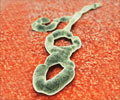
“Initial research by the WHO and CDC recommended disposing of Ebola-contaminated liquid waste into a latrine or treatment system without disinfection because the virus wasn’t expected to persist in wastewater,” explained Kyle J. Bibby, assistant professor of civil and environmental engineering at Pitt’s Swanson School of Engineering and principal investigator of the study. However, Bibby notes, “We found that the virus persisted over a period of at least eight days.”
The viral particle concentration in 2 samples spiked with different concentrations of the virus over an 8-day period. The testing was carried out in a secured lab in NIH. After the first day, the scientists observed a 99% decrease in concentration but the remaining viral particles were still detectable for the duration of the experiment.
“These results demonstrate a greater persistence of Ebola virus in wastewater than previously speculated,” said Charles Haas, co-author; head of the Department of Civil, Architectural, and Environmental Engineering.
“While the Ebola virus was found to be generally less persistent than enteric viruses in wastewater, the identified survival period might suggest a potential of a wastewater exposure route,” he said.
Earlier it was believed that the virus could be transmitted only through direct contact with body fluids, but there have there have been cases where people contracted the disease without coming in contact with infected fluids.
Advertisement
The viral particles appear to clump together or latch onto other particles in the water rather than dying. This looks like the virus’ seemingly early decay upon entry into the wastewater.
Advertisement
According to the WHO, the West Africa Ebola Virus Disease (EVD) outbreak has resulted in more than 28,000 cases and 11,000 fatalities.
Source-Medindia













